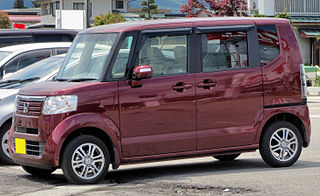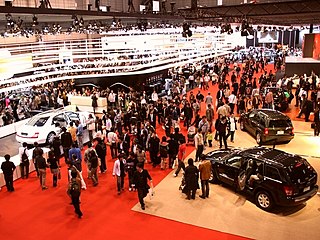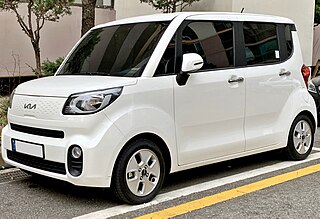
Kei car is the smallest category of Japanese expressway-legal motor vehicles. The term kei is a shortening of kei-jidōsha,, which translates to English as "light automobile".

The Honda EV Plus was an experimental electric vehicle which was the first battery electric vehicle from a major automaker that did not use lead–acid batteries. Roughly 340 EV Plus models were produced and released. Production of the EV Plus was discontinued in 1999 after Honda announced the release of its first hybrid electric vehicle, the Honda Insight.

The Honda Clarity is a nameplate used by Honda on alternative fuel vehicles. It was initially used only on hydrogen fuel-cell electric vehicles such as the 2008 Honda FCX Clarity, but in 2017 the nameplate was expanded to include the battery-electric Honda Clarity Electric and the plug-in hybrid electric Honda Clarity Plug-in Hybrid, in addition to the next generation Honda Clarity Fuel Cell. Clarity production ended in August 2021 with US leases for the fuel cell variant continuing through to 2022.

The Mitsubishi i is a kei car from automaker Mitsubishi Motors, first released in January 2006, twenty eight months after its debut at the 2003 Frankfurt Motor Show. It is the first four-door automobile since the 1960s to employ a "rear midship" setup with the engine behind the passengers, in an attempt to improve safety and interior space without enlarging the overall exterior.

The Japan Mobility Show (ジャパンモビリティショー), called Tokyo Motor Show (東京モーターショー) (TMS) until 2019, is a biennial auto show held in October–November at the Tokyo Big Sight, Tokyo, Japan for cars, motorcycles and commercial vehicles. Hosted by the Japan Automobile Manufacturers Association (JAMA), it is a recognized international show by the Organisation Internationale des Constructeurs d'Automobiles, and normally sees more concept cars than actual production car introductions, which is the reason why the automotive press sees the show as one of the motorshow's big five.

The Honda Life is an automobile nameplate that was used on various kei car/city cars produced by Honda: passenger cars, microvans, and kei trucks. The first series of the nameplate was built between 1971 and 1974, with the nameplate revived in 1997 and used until 2014. The Japanese-market Life has rarely been marketed outside Japan.

The Honda N360 is a small front-engine, front-wheel drive, two-door, four-passenger car manufactured and marketed by Honda from March 1967 through 1970 in Japan's highly regulated kei class — as both a two-door sedan and three-door wagon.
MIEV (Mitsubishi In-wheel motor Electric Vehicle) or MiEV (Mitsubishi innovative Electric Vehicle) is the name given by Japanese automaker Mitsubishi Motors (MMC) to its alternative propulsion technologies. From late 2006, “MiEV” encompasses all of Mitsubishi Motors’s electric drive systems work, including lithium-ion batteries, in-wheel motors and other technologies related to electric vehicle (EV), hybrid-electric vehicle and fuel-cell vehicles.

The Toyota iQ is a city car manufactured by Toyota and marketed in a single generation for Japan (2008–2016); Europe (2008–2015); and North America (2012–2015), where it was marketed as the Scion iQ. A rebadged variant was marketed in Europe as the Aston Martin Cygnet (2011–2013).

The Nissan Sakura is a battery electric kei car marketed by Nissan and produced by NMKV. Named after the national flower of Japan, it was introduced on 20 May 2022 as the first battery electric kei car from Nissan. It is developed and manufactured alongside the Mitsubishi eK X EV, which shares the same body with the petrol-powered eK X. Its design was previewed by the IMk concept which was showcased in 2019.
Toyota Concept Vehicles produced between 1990 and 1999 include:
Toyota concept vehicles are transportation devices manufactured or designed by automobile company Toyota from 2000 to 2009. As their name suggests, these vehicles were concepts, and, as such, many were never released to dealerships. Many were developed in conjunction with other corporations such as Sony or Subaru.
Toyota Concept Vehicles produced between 2010 and 2019 include:
A retro-style automobile is a vehicle that is styled to appear like cars from previous decades. Often these cars use modern technology and production techniques. This design trend developed in the early 1990s and led to almost all automobile brands introducing models that referenced previous cars of the 1950s and 1960s.

The Kia Ray is a city car manufactured by Kia exclusively for the South Korean domestic market. Based on the Kia Picanto/Morning, it was specifically developed in compliance with the "light car" category that offers tax incentives for cars with exterior dimensions below 3,600 mm (141.7 in) in length and below 1,600 mm (63.0 in) in width. This is a Korean-only vehicle.
The Honda EV Concept vehicles are a series of two concept electric cars created by the automobile division of Honda, designed with cues to historical Honda products. The Urban EV Concept made its debut at the 2017 International Motor Show Germany in September 2017, while the Sports EV Concept debuted at the Tokyo Motor Show a month later.

The Honda N-Van is a microvan produced by Honda for the Japanese market. The origin for the vehicle's name expresses "next generation light van" proposed by N series as see in the N-One, N-Box, and N-WGN: it is part of a renewed line-up of Kei class city cars. The use of the letter "N" in the name was used by Honda for the late 1960s and 1970s Honda N360.

The Honda e is an electric car that was manufactured by Japanese automaker Honda and sold in Japan from 2020 to 2024 and in Europe from 2020 to 2023. It is a supermini with a five-door hatchback design and a battery-electric powertrain that drives the rear wheels. The vehicle is styled with a retro look reminiscent of the first-generation Civic. It was previewed by the 2017 Urban EV Concept with the production version first shown publicly in 2019.
Ioniq is an automotive sub-brand and a division of Hyundai Motor Company with headquarters in Seoul, South Korea. The sub-brand was established in 2020 as a sub-brand for Hyundai's electric vehicle line-up. The sub-brand is slated to aid Hyundai to achieve a targeted 1 million electric vehicle sales annually by 2025, with the Ioniq brand projected to contribute 560,000 of those sales.

The Honda Prologue is a battery electric mid-size crossover SUV jointly developed by Honda and General Motors that is marketed in North America. Announced in October 2022 with sales starting in March 2024, it is Honda's first major electric vehicle following a number of low volume battery electric vehicles previously sold by Honda in North America, including the Honda Clarity, Honda Fit, and the experimental Honda EV Plus. Based heavily on the Chevrolet Blazer EV, the Prologue is comparable in size with the ICE-powered Passport.

















